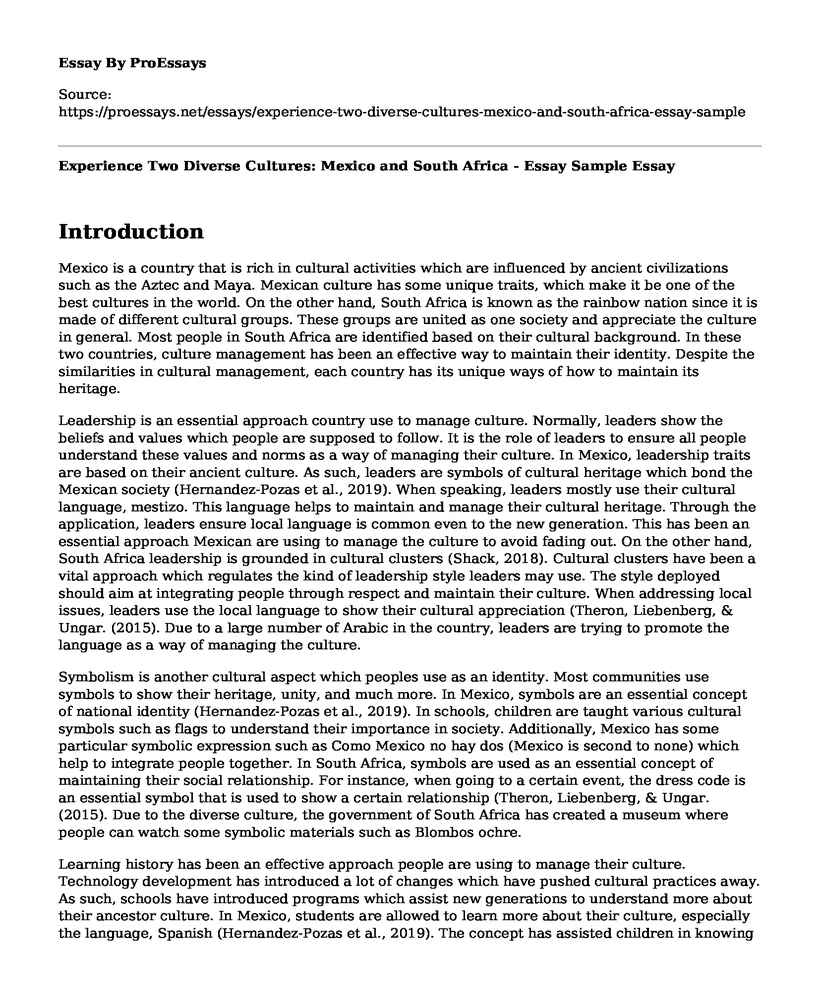Introduction
Mexico is a country that is rich in cultural activities which are influenced by ancient civilizations such as the Aztec and Maya. Mexican culture has some unique traits, which make it be one of the best cultures in the world. On the other hand, South Africa is known as the rainbow nation since it is made of different cultural groups. These groups are united as one society and appreciate the culture in general. Most people in South Africa are identified based on their cultural background. In these two countries, culture management has been an effective way to maintain their identity. Despite the similarities in cultural management, each country has its unique ways of how to maintain its heritage.
Leadership is an essential approach country use to manage culture. Normally, leaders show the beliefs and values which people are supposed to follow. It is the role of leaders to ensure all people understand these values and norms as a way of managing their culture. In Mexico, leadership traits are based on their ancient culture. As such, leaders are symbols of cultural heritage which bond the Mexican society (Hernandez-Pozas et al., 2019). When speaking, leaders mostly use their cultural language, mestizo. This language helps to maintain and manage their cultural heritage. Through the application, leaders ensure local language is common even to the new generation. This has been an essential approach Mexican are using to manage the culture to avoid fading out. On the other hand, South Africa leadership is grounded in cultural clusters (Shack, 2018). Cultural clusters have been a vital approach which regulates the kind of leadership style leaders may use. The style deployed should aim at integrating people through respect and maintain their culture. When addressing local issues, leaders use the local language to show their cultural appreciation (Theron, Liebenberg, & Ungar. (2015). Due to a large number of Arabic in the country, leaders are trying to promote the language as a way of managing the culture.
Symbolism is another cultural aspect which peoples use as an identity. Most communities use symbols to show their heritage, unity, and much more. In Mexico, symbols are an essential concept of national identity (Hernandez-Pozas et al., 2019). In schools, children are taught various cultural symbols such as flags to understand their importance in society. Additionally, Mexico has some particular symbolic expression such as Como Mexico no hay dos (Mexico is second to none) which help to integrate people together. In South Africa, symbols are used as an essential concept of maintaining their social relationship. For instance, when going to a certain event, the dress code is an essential symbol that is used to show a certain relationship (Theron, Liebenberg, & Ungar. (2015). Due to the diverse culture, the government of South Africa has created a museum where people can watch some symbolic materials such as Blombos ochre.
Learning history has been an effective approach people are using to manage their culture. Technology development has introduced a lot of changes which have pushed cultural practices away. As such, schools have introduced programs which assist new generations to understand more about their ancestor culture. In Mexico, students are allowed to learn more about their culture, especially the language, Spanish (Hernandez-Pozas et al., 2019). The concept has assisted children in knowing and appreciating their cultural history. The government of South Africa engages cultural history in the curriculum to learn more about their culture (Theron, Liebenberg, & Ungar. (2015). Additionally, the curriculum engages some neighboring culture such as, Khoisan, to manage Africa heritage.
Conclusion
In conclusion, Mexico and South Africa effectively engage various approaches to manage their culture. Each country deploys its unique ways to manage its culture. Leadership, symbolism, and learning are some of the concept used in the management of culture.
References
Hernandez-Pozas, O., Chamoun-Nicolas, H., & Hazlett, R. D. (2019). Negotiating with Managers from Mexico. In The Palgrave Handbook of Cross-Cultural Business Negotiation (pp. 169-187). Palgrave Macmillan, Cham. Retrieved from dlib.scu.ac.ir/bitstream/Hannan/562375/1/9783030002763.pdf#page=191.
Shack, W. A. (2018). The Gurage: a people of the ensete culture. Routledge.
Theron, L., Liebenberg, L., & Ungar, M. (2015). Youth resilience and culture. Springer.[MU].
Cite this page
Experience Two Diverse Cultures: Mexico and South Africa - Essay Sample. (2023, Feb 14). Retrieved from https://proessays.net/essays/experience-two-diverse-cultures-mexico-and-south-africa-essay-sample
If you are the original author of this essay and no longer wish to have it published on the ProEssays website, please click below to request its removal:
- Essay Sample on Trump`s Afghan Strategy
- Essay Example on Racial and Nationalism in WW1: A Historical Analysis
- The Aftermath of WWI: Development and Loss - Essay Sample
- Essay Example on Sidney Poitier: Achieving Perfection Through Practice
- Essay Example on Mystery of the Ancient Egyptian Pyramids: A Wonder of the Ages
- Essay Example on Superheroes: Increasing Diversity in the Modern World
- Paper Example on Surf Wax







